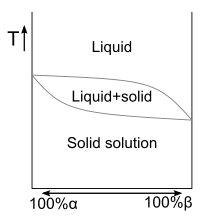- Solid solution
-
A solid solution is a solid-state solution of one or more solutes in a solvent. Such a mixture is considered a solution rather than a compound when the crystal structure of the solvent remains unchanged by addition of the solutes, and when the mixture remains in a single homogeneous phase. This often happens when the two elements (generally metals) involved are close together on the periodic table; conversely, a chemical compound is generally a result of the non-proximity of the two metals involved on the periodic table.[1]
Contents
Details
The solute may incorporate into the solvent crystal lattice substitutionally, by replacing a solvent particle in the lattice, or interstitially, by fitting into the space between solvent particles. Both of these types of solid solution affect the properties of the material by distorting the crystal lattice and disrupting the physical and electrical homogeneity of the solvent material.[2]
Some mixtures will readily form solid solutions over a range of concentrations, while other mixtures will not form solid solutions at all. The propensity for any two substances to form a solid solution is a complicated matter involving the chemical, crystallographic, and quantum properties of the substances in question. Solid solutions, in accordance with the Hume-Rothery rules, may form if the solute and solvent have:
- Similar atomic radii (15% or less difference)
- Same crystal structure
- Similar electronegativities
- Similar valency
The phase diagram in Fig. 1 displays an alloy of two metals which forms a solid solution at all relative concentrations of the two species. In this case, the pure phase of each element is of the same crystal structure, and the similar properties of the two elements allow for unbiased substitution through the full range of relative concentrations.
Solid solutions have important commercial and industrial applications, as such mixtures often have superior properties to pure materials. Many metal alloys are solid solutions. Even small amounts of solute can affect the electrical and physical properties of the solvent.
The binary phase diagram in Fig. 2 at right shows the phases of a mixture of two substances in varying concentrations, α and β. The region labeled "α" is a solid solution, with β acting as the solute in a matrix of α. On the other end of the concentration scale, the region labeled "β" is also a solid solution, with α acting as the solute in a matrix of β. The large solid region in between the α and β solid solutions, labeled "α and β", is not a solid solution. Instead, an examination of the microstructure of a mixture in this range would reveal two phases — solid solution α-in-β and solid solution β-in-α would form separate phases, perhaps lamella or grains.
Application
In the phase diagram, the unalloyed extreme left and right concentrations, and the dip in the center, the material will be solid and become liquid as heat is added, where at other proportions the material will enter a mushy or pasty phase. The mixture at dip point of the diagram is called a eutectic alloy. Lead-tin mixtures formulated at that point (37/63 mixture) are useful when soldering electronic components, particularly if done manually, since the solid phase is quickly entered as the solder cools. In contrast, when lead-tin mixtures were used to solder seams in automobile bodies a pasty state enabled a shape to be formed with a wooden paddle or tool, so a 70-30 lead to tin ratio was used. (Lead is being removed from such applications owing to its toxicity and consequent difficulty in recycling devices and components that include lead.)
Exsolution
When a solid solution becomes unstable — due to a lower temperature, for example — exsolution occurs and the two phases separate into distinct microscopic to megascopic lamellae. This is mainly caused due to difference in cation size. Cations who have a large difference in radii are not likely to readily substitute.[3]
Take the alkali feldspar minerals for example, whose end members are albite, NaAlSi3O8 and microcline, KAlSi3O8. At high temperatures Na+ and K+ readily substitute for each other and so the minerals will form a solid solution, yet at low temperatures albite can only substitute a small amount of K+ and the same applies for Na+ in the microcline, this leads to exsolution where they will separate into two separate phases. In the case of the alkali feldspar minerals, thin white albite layers will alternate between typically pink microcline.[3]
Examples
- Chen, Jing; Xu, Zhi-qin; Chen, Z-Z.; Li, T-F.; Chen, F-Y. (December 2005). "Pargasite and ilmenite exsolution texture in clinopyroxene from the Hujialing Garnet-Pyroxenite, Su-lu U.H.P. Terrane, Central China: A geodynamic Implication". European Journal of Mineralogy 17 (6): 895–903. doi:10.1127/0935-1221/2005/0017-0895. http://www.uni-graz.at/IEC-7/PDF-files/Chen.pdf.
- Petersen, U.. "Introduction to Ore Microscopy II; Mineral Paragenesis". http://www.mines.utah.edu/~wmep/59298/592PDF/rlm2.pdf.
See also
References
- ^ Cottrell, Alan Howard (1967). An Introduction to Metallurgy. Institute of Materials. ISBN 0844807672.
- ^ Callister Jr., William D. (2006). Materials Science and Engineering: An Introduction (7th ed.). John Wiley & Sons. ISBN 0471354465.
- ^ a b Nesse, William D. (2000). Introduction to Mineralogy. New York: Oxford University Press. p91-92. ISBN: 978-0-19-510691-6
External links
Articles related to solutions Solution Ideal solution · Aqueous solution · Solid solution · Buffer solution · Flory-Huggins · Mixture · Suspension · Colloid · Phase diagram · Eutectic point · Alloy · Saturation · Supersaturation · Serial dilution · Dilution (equation) · Apparent molar propertyConcentration
and related quantitiesMolar concentration · Mass concentration · Number concentration · Volume concentration · Normality · Percentage solution · Molality · Mole fraction · Mass fraction · Mixing ratioSolubility Solubility equilibrium · Total dissolved solids · Solvation · Solvation shell · Enthalpy of solution · Lattice energy · Raoult's law · Henry's law · Solubility table (data) · Solubility chartSolvent Categories:
Wikimedia Foundation. 2010.


